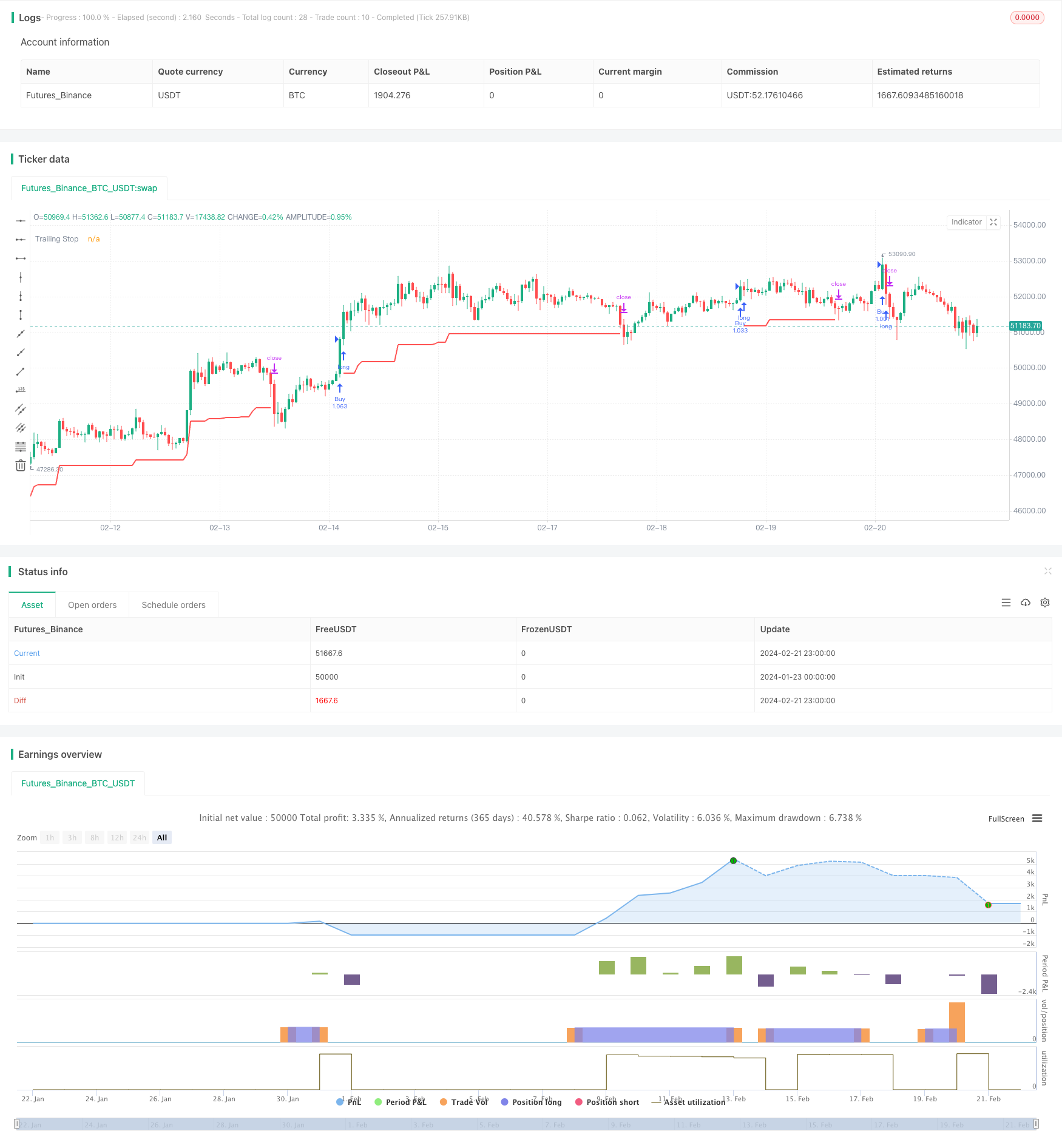モメントブレイク戦略
作者: リン・ハーンチャオチャン, 日付: 2024-02-23 14:27:21タグ:

概要
モメントブレイクストラテジーは,市場の勢いを追跡するトレンドフォローする戦略である.それは,市場が現在上向きか下向きの傾向にあるかどうかを判断するために複数の指標を組み合わせ,主要なレジスタンスレベルを突破するとロングポジションを開き,主要なサポートレベルを突破するとショートポジションを開く.
戦略の論理
この戦略は主に複数のタイムフレームのドンチアンチャネルを使用して,市場のトレンドと主要な価格レベルを決定する.特に,価格が40日などの長期ドンチアンチャネルの上部レールを突破すると,上昇傾向とみなされる.年間内の新高値や移動平均の調整などの追加のフィルターとともに,ロングシグナルが誘発される.価格が長期ドンチアンチャネルの下部レールの下部レールを突破すると,ダウントレンドとして判断される.年間内の新低値のようなフィルターとともに,ショートシグナルが誘発される.
この戦略は,出口ポジションの2つのオプションを提供します:固定無効化ラインとトライリングストップ損失.固定無効化ラインは,20日などの短いドンチアン運河の下/上レールを使用します.トライリングストップ損失は,ATR値に基づいて毎日動的ストップ損失ラインを計算します.両方の方法はリスクを効果的に制御することができます.
利点分析
この戦略は,トレンド判断とブレイクアウトオペレーションを組み合わせ,市場の短期的な方向性の機会を効果的に捉える.単一の指標と比較して,いくつかの偽ブレイクアウトをフィルターし,エントリーシグナルの品質を改善できる複数のフィルターを使用する.さらに,ストップロスの戦略の適用は,その回復力を高め,市場が短期間引き戻しても損失を効果的に制御することができます.
リスク分析
この戦略の主なリスクは,価格が激しく変動し,出口ポジションにストップロスを引き起こす可能性があることです.価格が後に急速に逆転した場合,機会が逃れることがあります.さらに,複数のフィルターの使用は,いくつかの機会をフィルタリングし,取引の頻度を減らすこともあります.
リスクを減らすために,ATR倍数を調整したり,ドンチアンチャネル間隔を拡大してストップロスの確率を減らすこともできます.入力の頻度を増やすために,いくつかのフィルターを削除または緩和することもできますが,リスクも増加します.
オプティマイゼーションの方向性
この戦略は,次の側面で最適化できます.
- ドンチアン・チャネルの長さを最適化して パラメータの最適な組み合わせを見つけます
- フィルターとして異なる種類の移動平均を試してください
- ATR マルチプリキュアを調整するか,ストップ・ロスの固定ポイントを使用します.
- MACDのような傾向判断指標を追加します.
- 年間内の新高値/低値等を振り返る期間を最適化する
異なるパラメータをテストすることで リスクと収益をバランスさせる最適な組み合わせを見つけることができる.
結論
この戦略は,トレンド方向を決定するために複数の指標を組み合わせ,主要なブレイクアウトレベルで取引を誘発する.ストップ損失メカニズムはリスクにも耐性がある.パラメータを最適化することで,安定した過剰収益を達成することができる.市場について明確な見解がないが,トレンドを追求したい投資家に適している.
/*backtest
start: 2024-01-23 00:00:00
end: 2024-02-22 00:00:00
period: 1h
basePeriod: 15m
exchanges: [{"eid":"Futures_Binance","currency":"BTC_USDT"}]
*/
// This source code is subject to the terms of the Mozilla Public License 2.0 at https://mozilla.org/MPL/2.0/
// © HeWhoMustNotBeNamed
//@version=4
strategy("BuyHigh-SellLow Strategy", overlay=true, initial_capital = 10000, default_qty_type = strategy.percent_of_equity, default_qty_value = 100, commission_type = strategy.commission.percent, pyramiding = 1, commission_value = 0.01, calc_on_order_fills = true)
donchianEntryLength = input(40, step=10)
donchianExitLength = input(20, step=10)
considerNewLongTermHighLows = input(true)
shortHighLowPeriod = input(120, step=10)
longHighLowPeriod = input(180, step=10)
considerMAAlignment = input(true)
MAType = input(title="Moving Average Type", defval="ema", options=["ema", "sma", "hma", "rma", "vwma", "wma"])
LookbackPeriod = input(40, minval=10,step=10)
atrLength = input(22)
atrMult = input(4)
exitStrategy = input(title="Exit Strategy", defval="tsl", options=["dc", "tsl"])
considerYearlyHighLow = input(true)
backtestYears = input(10, minval=1, step=1)
f_getMovingAverage(source, MAType, length)=>
ma = sma(source, length)
if(MAType == "ema")
ma := ema(source,length)
if(MAType == "hma")
ma := hma(source,length)
if(MAType == "rma")
ma := rma(source,length)
if(MAType == "vwma")
ma := vwma(source,length)
if(MAType == "wma")
ma := wma(source,length)
ma
f_getTrailingStop(atr, atrMult)=>
stop = close - atrMult*atr
stop := strategy.position_size > 0 ? max(stop, stop[1]) : stop
stop
f_getMaAlignment(MAType, includePartiallyAligned)=>
ma5 = f_getMovingAverage(close,MAType,5)
ma10 = f_getMovingAverage(close,MAType,10)
ma20 = f_getMovingAverage(close,MAType,20)
ma30 = f_getMovingAverage(close,MAType,30)
ma50 = f_getMovingAverage(close,MAType,50)
ma100 = f_getMovingAverage(close,MAType,100)
ma200 = f_getMovingAverage(close,MAType,200)
upwardScore = 0
upwardScore := close > ma5? upwardScore+1:upwardScore
upwardScore := ma5 > ma10? upwardScore+1:upwardScore
upwardScore := ma10 > ma20? upwardScore+1:upwardScore
upwardScore := ma20 > ma30? upwardScore+1:upwardScore
upwardScore := ma30 > ma50? upwardScore+1:upwardScore
upwardScore := ma50 > ma100? upwardScore+1:upwardScore
upwardScore := ma100 > ma200? upwardScore+1:upwardScore
upwards = close > ma5 and ma5 > ma10 and ma10 > ma20 and ma20 > ma30 and ma30 > ma50 and ma50 > ma100 and ma100 > ma200
downwards = close < ma5 and ma5 < ma10 and ma10 < ma20 and ma20 < ma30 and ma30 < ma50 and ma50 < ma100 and ma100 < ma200
upwards?1:downwards?-1:includePartiallyAligned ? (upwardScore > 5? 0.5: upwardScore < 2?-0.5:upwardScore>3?0.25:-0.25) : 0
//////////////////////////////////// Calculate new high low condition //////////////////////////////////////////////////
f_calculateNewHighLows(shortHighLowPeriod, longHighLowPeriod, considerNewLongTermHighLows)=>
newHigh = highest(shortHighLowPeriod) == highest(longHighLowPeriod) or not considerNewLongTermHighLows
newLow = lowest(shortHighLowPeriod) == lowest(longHighLowPeriod) or not considerNewLongTermHighLows
[newHigh,newLow]
//////////////////////////////////// Calculate Yearly High Low //////////////////////////////////////////////////
f_getYearlyHighLowCondition(considerYearlyHighLow)=>
yhigh = security(syminfo.tickerid, '12M', high[1])
ylow = security(syminfo.tickerid, '12M', low[1])
yhighlast = yhigh[365]
ylowlast = ylow[365]
yhighllast = yhigh[2 * 365]
ylowllast = ylow[2 * 365]
yearlyTrendUp = na(yhigh)? true : na(yhighlast)? close > yhigh : na(yhighllast)? close > max(yhigh,yhighlast) : close > max(yhigh, min(yhighlast, yhighllast))
yearlyHighCondition = ( (na(yhigh) or na(yhighlast) ? true : (yhigh > yhighlast) ) and ( na(yhigh) or na(yhighllast) ? true : (yhigh > yhighllast))) or yearlyTrendUp or not considerYearlyHighLow
yearlyTrendDown = na(ylow)? true : na(ylowlast)? close < ylow : na(ylowllast)? close < min(ylow,ylowlast) : close < min(ylow, max(ylowlast, ylowllast))
yearlyLowCondition = ( (na(ylow) or na(ylowlast) ? true : (ylow < ylowlast) ) and ( na(ylow) or na(ylowllast) ? true : (ylow < ylowllast))) or yearlyTrendDown or not considerYearlyHighLow
label_x = time+(60*60*24*1000*1)
[yearlyHighCondition,yearlyLowCondition]
donchian(rangeLength)=>
upper = highest(rangeLength)
lower = lowest(rangeLength)
middle = (upper+lower)/2
[middle, upper, lower]
inDateRange = true
[eMiddle, eUpper, eLower] = donchian(donchianEntryLength)
[exMiddle, exUpper, exLower] = donchian(donchianExitLength)
maAlignment = f_getMaAlignment(MAType, false)
[yearlyHighCondition, yearlyLowCondition] = f_getYearlyHighLowCondition(considerYearlyHighLow)
[newHigh,newLow] = f_calculateNewHighLows(shortHighLowPeriod, longHighLowPeriod, considerNewLongTermHighLows)
maAlignmentLongCondition = highest(maAlignment, LookbackPeriod) == 1 or not considerMAAlignment
atr = atr(atrLength)
tsl = f_getTrailingStop(atr, atrMult)
//U = plot(eUpper, title="Up", color=color.green, linewidth=2, style=plot.style_linebr)
//D = plot(exLower, title="Ex Low", color=color.red, linewidth=2, style=plot.style_linebr)
longCondition = crossover(close, eUpper[1]) and yearlyHighCondition and newHigh and maAlignmentLongCondition
exitLongCondition = crossunder(close, exLower[1])
shortCondition = crossunder(close, eLower[1]) and yearlyLowCondition and newLow
exitShortCondition = crossover(close, exUpper[1])
strategy.entry("Buy", strategy.long, when=longCondition and inDateRange, oca_name="oca_buy")
strategy.exit("ExitBuyDC", "Buy", when=exitStrategy=='dc', stop=exLower)
strategy.exit("ExitBuyTSL", "Buy", when=exitStrategy=='tsl', stop=tsl)
plot(strategy.position_size > 0 ? (exitStrategy=='dc'?exLower:tsl) : na, title="Trailing Stop", color=color.red, linewidth=2, style=plot.style_linebr)
//strategy.close("Buy", when=exitLongCondition)
- スペースアウト トレーディング 戦略
- ストックRSI トレーディング戦略
- 価格アクションに基づく機関トレーダー戦略
- レインボーオシレーター取引戦略
- 動向平均の組み合わせに基づく戦略をフォローする傾向
- 平均線突破戦略
- 多項式尾行停止戦略
- SPY RSI ストーカスティクス クロスオーバー トレンド逆転戦略
- ATR と EMA に基づくトレンド フォロー 戦略
- ボリンジャー帯とMACDに基づく定量取引戦略
- マルボツーキャンドルレンジバランス戦略
- 4つの横断戦略
- 逆ボリンガー帯 RSI MACD 量子戦略
- RSI移動平均 双交差振動戦略
- 移動平均を横切るRR戦略
- DCAの戦略は,利益を引き継いでいる
- スーパートレンド ボリンガー帯 双動平均取引戦略
- 移動平均のクロスオーバー取引戦略
- 戦略をフォローするSMAシステム傾向
- 複数の時間枠のRSI取引戦略